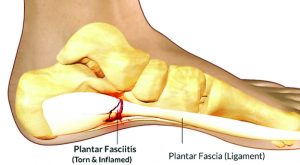By Dr.Brian C. Rell, DPM, FACFAS
 Whether young or old, most people lucky enough to live in Florida appreciate the great outdoors. The weather and sunshine allow Floridians and visitors alike time well-spent kayaking, golfing, playing tennis, jogging, and participating in competitive sports for the majority of the year.
Whether young or old, most people lucky enough to live in Florida appreciate the great outdoors. The weather and sunshine allow Floridians and visitors alike time well-spent kayaking, golfing, playing tennis, jogging, and participating in competitive sports for the majority of the year.
While exercising outdoors is a healthy luxury, ballistic movements through exercise and sports-
related activities can cause a great deal of wear and tear on the feet and ankles. Some of the most common injuries are sprains, strains, torn ligaments and bone spurs.
Achilles Tendon
The Achilles tendon is the largest tendon in the body. It’s connected to both the calf muscle and the heel bone and is a fibrous tissue that somewhat resembles twine. It is tensed and flexed when we walk, run, stand, jump and is especially stressed when you move quickly from side to side.
Although the Achilles tendon can withstand high stresses from most movements, it is extremely vulnerable to injury. Ruptures of the tendon are either the complete separation of the tendon fibers or partial tearing so that the tendon can no longer perform its normal function.
Treatment Options
• Rest
• Compression
• Gradual repositioning through casting and recasting
• Reconnecting the two ends of the tear
• Suturing the tear
• Flap is drawn down from gastrocnemius (calf muscle)
• Donated graft repair
• Suturing method to tie down and reconnect the midline tear
Nonsurgical repair has a much greater re-rupture rate than with surgery.
Plantar fasciitis
Plantar fasciitis is one of the most common foot disorders. The foot is made up of many different bones, joints, tendons, and ligaments these include the plantar fascia. The plantar fascia is a band of tissue similar to ligaments. It stretches from the heel of your foot to the middle, and it’s responsible for supporting your arch. Plantar fasciitis doesn’t happen overnight; small tears that occur over an extended period of time are usually the cause of the injury. However, sudden strenuous movements, like jumping, or running can take your pain over the edge and cause extreme discomfort and debilitation.
On its own, the plantar fascia takes a very long time to heal, so along with your podiatrist’s treatment recommendations, proper home care is the key to getting your foot’s function back to normal.
Treatment Options
• Rest/Compression
• Home exercises focusing on stretching of the hamstrings, calf and plantar fascia
• NSAID’s such as Advil/Aleve or Rx medication
• Foot orthotics (Prefabricated vs Rx)
• Physical Therapy; including ART/Graston techniques
• PRP / Stem Cell Injections
• In some cases, Corticosteroid injections
• Night splints
• Lastly, minimally invasive surgical options
Toe Issues: Bunions
More women than men experience the painful boney growth on their big toe, known as a bunion, or Hallux Valgus. One of the leading causes of a bunion is from wearing shoes that are too tight, too narrow or too high. All of this causes pressure on your toe joint, which in turn starts to ache, become fluid filled and can have boney growths.
Uniquely, bunions can also be hereditary and run in families, especially in females, generation after generation. A form of arthritis can also cause these painful, red, boney, growths.
Hammertoe
Hammertoe can be genetic and many times occurs in people with either a high arch or a flat foot. When the muscles in your toes get out of balance, they can start contracting abnormally. This causes the toe to bend in an upward position in the middle joint of the toe. When this happens, it can create severe pain. Various forms of arthritis can contribute to this issue as well. And unfortunately, ill-fitting footwear can also cause hammertoe, due to pushing the toes out of their normal position for long periods of time.
Turf Toe
The big toe joint gets extreme wear and tear from running, sprinting off of the foot, jumping and balancing the body, so it’s not surprising that one of the leading injuries in sports or for active individuals is a sprained toe joint referred to as turf toe.
Toe Treatment Options
• Rest
• Wear wider more comfortable shoes
• Wrapping or padding the toe
• Use foam or gel pads
• Try stretching exercises
• Minimally invasive surgery to remove growths
• Outpatient surgery, to redirect the lower tendons of the toe to the top of the toe to help straighten it into the correct position
Whether it’s you, your children, or someone you know that sustains sprains, tears, or other painful injuries to your feet or ankles, it’s imperative that you seek out the best podiatric care to ensure you heal correctly and to eliminate future relapse or recurrence.
Dr. Brian C. Rell, DPM, FACFAS
Dr. Rell is double board certified by the Board of Foot and Ankle Surgery and specializes in the treatment of all podiatric and orthopedic foot, ankle, and lower leg conditions. Dr. Rell graduated from Temple University School of Podiatric Medicine in 1999 and completed his reconstructive surgical residency at The Graduate Hospital in Philadelphia, where he served as chief resident. He has been in private practice in the Sarasota and Bradenton area for over 15 years.








